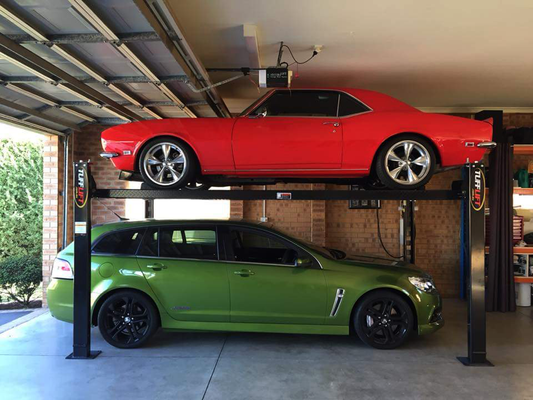7 Signs It’s Time to Replace Your Car Lift
Share
A car lift is one of the most essential tools in any workshop or garage.
Whether you use a 2 post hoist or a 4 post hoist, it plays a crucial role when undertaking mechanical repairs, inspections, and even vehicle storage.
But like all equipment, car lifts don’t last forever. Recognising the signs of wear and failure is key to maintaining an efficient workspace and a safe working environment.
In this blog, we’ll cover the most common signs that your hoist needs updating and explain why you should choose Tufflift for a reliable replacement.
Upgrade your ageing or outdated vehicle hoist with a durable new car hoist from Tufflift. Call us on 1800 88 33 50 to ask about our range.
1. Visible Wear or Damage
The most obvious indication that your hoist needs replacing is if it has visible wear and tear.
Over time, frequent use, heavy loads, and environmental factors can weaken critical components, compromising safety and performance.
Look out for:
-
Cracks, rust, or corrosion on the lift structure or base plate, especially around welds and joints.
-
Frayed or worn chains, cables and sheaves. They can lead to sudden failures.
-
Bent or misaligned arms that no longer lock securely in place.
-
Loose or worn anchor bolts, as they can cause unsafe lifting conditions.
-
Damaged concrete around floor anchors. It could be a sign of structural instability.
2. Hydraulic Fluid Leaks
Another clear sign of a failing car hoist is if it’s leaking hydraulic fluid.
Hydraulic fluid is essential for smooth and reliable lifting. Any leaks can indicate worn seals, damaged hoses, or failing hydraulic cylinders.
Puddles or drips forming around the base of a hoist indicate hydraulic issues. Other signs include reduced lifting power, unstable or uneven lifting, and visible wear on hydraulic hoses or fittings.
3. Slow Operation
If your automotive hoist is taking longer than usual to raise or lower vehicles, something is wrong. Slow operation is more than just a nuisance—it can impact productivity and efficiency.
Common causes include:
-
Worn seals or valves, leading to reduced hydraulic efficiency.
-
Clogged or damaged hydraulic lines restrict fluid flow and slow the lifting process.
-
Ageing motors or pumps that are no longer functioning at optimal speed.
4. Unusual Noises
Never ignore odd or persistent noises coming from automotive car lifts, such as grinding, squeaking, banging or popping.
They can signal underlying mechanical issues that might compromise the safety and efficiency of the lift.
Unusual noises could be a sign of worn-out bearings or gears or loose or damaged bolts and nuts. Friction between metal components or hydraulic system issues, such as air trapped in the lines, can also present problems.
5. Insufficient Lifting Capacities
If your vehicle lift can no longer accommodate heavy vehicles or the increased workload of your shop, it’s time for an upgrade.
Over time, hoists may lose their lifting height capacity. Signs include:
-
Difficulty lifting vehicles to the desired height or uneven lifting.
-
Frequent strain on the lifting components indicates they are being pushed beyond their limits.
-
Overloaded lift resulting in unsafe operation and potential breakdowns.
Even if your current hoist is in good working condition, you may need a new one to meet your evolving business needs, such as upgrading from a 2 post car hoist to a 4 post car hoist.
6. Failure to Meet Safety Standards
Safety should always be a priority when working with an automotive car hoist.
If your hoist doesn’t meet safety standards, replacing it before it becomes a liability is essential.
Critical safety features like safety locks or restraints might malfunction, preventing the hoist from holding a vehicle securely in place. An inconsistent or delayed response from the emergency stop function could also prove problematic.
Outdated lift designs that don’t adhere to the latest industry regulations and safety codes are yet another reason to seek out a new portable car hoist.
7. Frequent Repairs and Downtime
As vehicle hoists age, you may find that the need for repairs becomes more constant, leading to extended downtime.
Not only does this affect your shop’s productivity, but it also means higher costs over time. Frequent repairs could indicate:
-
Ageing components are no longer functioning properly or efficiently.
-
Parts replacements aren’t providing long-term fixes.
-
Decreasing reliability results in unanticipated breakdowns.
In most cases, purchasing a new lift is more cost-effective than continuing to pay for regular maintenance each time a component on your old lift breaks.
Ready for an Upgrade? Trust Tufflift Car Hoists
If you’re on the hunt for a new automotive lift for cars and trucks, look no further than Tufflift.
We are one of Australia’s leading hoist manufacturing and distribution companies. Our heavy-duty lifts are built for all conditions and settings, from industrial and commercial spaces to basic home garage setups.
Every auto hoist lift design is engineer-certified and Worksafe-registered. So, you’ll have peace of mind knowing any product you choose is safe, secure and up to industry standards.
Our range of high-quality 2 and 4 post car hoists is perfect for automotive professionals and hobbyists alike. Call or email the team at Tufflift today, and we’ll help you find the right hoist model for your requirements.




